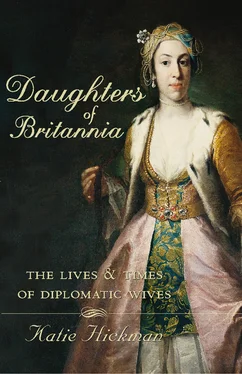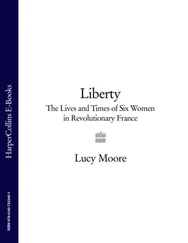In writing Daughters of Britannia I have drawn on the experiences of more than 100 diplomatic women. Their lives span nearly 350 years of history, and encompass almost every imaginable geographical and cultural variation, from the glittering social whirl enjoyed by Countess Granville in Paris after the Napoleonic Wars, to the privations suffered at the turn of this century by that redoubtable Scotswoman, Catherine Macartney, who in her seventeen years in Kashgar, in Chinese Turkistan, saw only three other European women.
Many of these women lived unique lives. Some saw sights which no other English person, man or woman, had ever seen. And yet, despite their vast differences – in character and taste as much as circumstances – a bond of shared experience unites them; a diplomatic ‘culture’ which was both official and intensely personal. Even though they are separated by nearly 200 years, when the anguished Countess of Elgin writes about her longing for news from home, it could be my own mother writing.
Dearest Mother,
Do not expect this to be an agreeable letter. I am too much disappointed in never hearing from home; the 17th July is the last from you, almost six months!… I can’t imagine why you took it into your heads that we were going home; for I am sure I wrote constantly to tell you that we were at Constantinople, and why you would not believe me I know not. If you knew what I felt when the posts arrive and no letters for me, I am sure you would pity me. I shall write to nobody but you, for I feel I am too cross. 3
In the Elgins’ day the journey from England to Constantinople was not only long and arduous, it was also hazardous. Messengers were frequently attacked and robbed, and every single precious letter either destroyed or lost. Amazingly, even in the late twentieth century the non-arrival of the bag has been the cause of as much disappointment and pain. Here is my mother to my brother on 23 May 1978: ‘Darling Matthew, Boo hoo! The bag has let us down, and there is gnashing of teeth here, and blood is boiling.’ And to myself, on the same day: ‘Darling Katie, The bloody bag has let us down yet again and we have no letters from any of you. We are so mad we could spit …’
What qualities were needed in a diplomat’s wife? In Mary Elgin’s day nobody would have thought it necessary to enumerate them. Of course, plenty was written on the qualities required in a man. In the sixteenth century, when the idea of sending a resident ambassador abroad was still fairly new, these were frequently listed in treaties and manuals. A man (in Sir Henry Wotton’s famously ambiguous phrase) ‘sent to lie abroad for the good of his country’ was required to have an almost impossibly long list of attributes. He should be not only tall, handsome, well-born and blessed with ‘a sweet voice’ and ‘a well-sounding name’, 4 but also well read in literature, in civil and canon law and all branches of secular knowledge, in mathematics, music geometry and astronomy. He should be able to converse elegantly in the Latin tongue and be a good orator. He should also be of fine and upstanding morals: loyal, brave, temperate, prudent and honest.
An important ambassador’s entourage could include secretaries and ‘intelligencers’, a chaplain, musicians, liverymen, a surgeon, trumpeters, gentlemen of the horse, ‘gentlemen of quality who attended for their own pleasure’, young nephews ‘wanting that polish that comes from a foreign land’, even dancing and fencing masters. But never a wife.
The ideal diplomatic wife was more difficult to describe: ‘Just as the right sort can make all the difference to her husband’s position,’ wrote Marie-Noele Kelly rather forbiddingly in her memoirs, ‘so one who is inefficient, disagreeable, disloyal, or even merely stupid, can be a millstone around his neck.’ 5 Although there have been some magnificent millstones – Lady Townley’s infamous ‘indiscretions’ forced her husband to retire from the service – there is no doubt that all the staunchest qualities deemed necessary in men were required in their wives, too. Circumstances have often demanded of them unimaginable courage and reserves of fortitude.
This book is the story of how such women survived. It is the story of many lives lived valiantly far away from family and friends; and of the uniquely demanding diplomatic culture which sustained (and sometimes failed to sustain) these women as they struggled, often in very difficult conditions, to represent their country abroad. Although their role, in the eyes of ‘his-story’, lay very much behind the scenes, I believe that this is precisely why their testimony is so valuable: it was in coping with quite ordinary things, with the daily round of life, that their resilience and resourcefulness found its greatest expression.
My only regret is for the lives which, even after more than two years’ searching, have continued to elude me. So it is only in my imagination that I can describe for you what it must have been like for Lady Winchilsea as she sailed into Constantinople, that city of marvels, by her husband’s side that afternoon. Perhaps she, like the ambassador, was dressed in her court robes, still fusty and foul-smelling from their long confinement in a damp sea-trunk. Dolphins were still a common sight in the Bosphorus in those days, and I like to think of her watching them riding the bow-waves in front of the ship as it came into the harbour at last, the fabled city rising before them, its domes and minarets shining in the pink and gold light.
*Helen Pickard, the wife of the deputy high commissioner.
*Manuscript copies of these documents, often written in the form of relazione (‘A narrative of …’), were considered so valuable that they often commanded large sums, even in their own time.
†Previously, the role of an ambassador was usually to complete a short-term mission – to declare war or negotiate a treaty. England’s first permanent ambassador, John Shirwood, became resident in Rome in 1479. In 1505 John Stile was sent to Spain by Henry VII, where he became the first resident ambassador to a secular court. By the mid-seventeenth century the idea of permanent missions abroad was no longer a novelty in England, but neither was it a universal practice. During the Restoration (1660–68) the crown sent diplomatic missions to thirty countries, but permanent embassies to only five (France, Spain, Portugal, the United Provinces and the Hanse towns of Hamburg, Bremen and Lübeck). Turkey and Russia were in a special category: ambassadors were sent there in the name of the monarch, but were in fact paid servants of the Turkey Company or British merchants settled in Moscow.
*Colonel Sheil was the British minister in Tehran on the eve of the Crimean War.
It was the late afternoon when His Excellency the Earl of Winchilsea, Ambassador Extraordinary from King Charles II to the Grand Seignior Mehmed IV, Sultan of Sultans and God’s Shadow upon Earth, sailed into Constantinople.
To arrive in Constantinople by sea, even today, is to be presented with an extraordinary sight. In 1661 it was one of the wonders of the world. Built on seven hills, and surrounded on three sides by water, it was described by contemporary travellers as not only the biggest and richest, but also the most beautiful city on earth. The unequal heights of the seven hills, each one topped with the gilded dome and minarets of a mosque, made the city seem almost twice as large as it really was. On each hillside, raised one above the other in an apparent symmetry, were palaces, pavilions and mansions, each one set in its own gardens, surrounded by groves of cypress and pine. On the furthermost spit of land, and clearly visible from the sea, was the Seraglio, * the Sultan’s palace, its turrets and domes reflected in the waters of the Bosphorus.
Читать дальше












